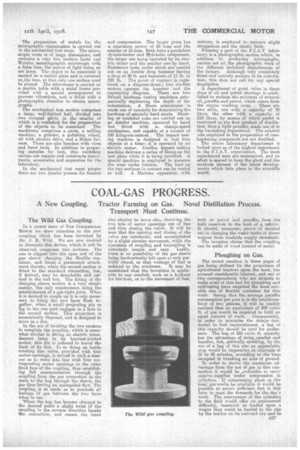AN UP-TO-DATE LABORATORY.
Page 14

Page 15

If you've noticed an error in this article please click here to report it so we can fix it.
THE DIRECTORATE of every leading motor factory realizes the importance of a chemical, mechanical, and micrographic laboratory as a control on the material used in the production of
motor vehicles. The Co., which has always attached considerable importance to laboratory work, laid the foundations of such a department 12 years ago, and at the present time claims to have the finest privately-owned laboratory in Italy, if not in Europe.
The different departments comprise a chemical laboratory, metallography room, mechanical test section, a-..photographic section, and a section for various products, comprising varnishes, case hardening compounds, etc.
The chemical laboratory is a very fine hall, with four work tables for titrations, quantitative electrolysis, distillations, extractions, etc. There is also a series of 12 burettes, bench and frame for electrolysis, hot air desiccating furnace, &millets apparatus, stills, blow pipe, 'water bath, small fume cupboard for sand bath evaporations, and reagents cupboards.
There is a separate room for quantitative estimation of carbon sulphur. Against the walls are fitted two Corleis apparatus, one opposite the other, for the estimation of carbon ; the operator can thus watch both the apparatus, in which carbon of iron, cast-iron or steel are oxydized by a chromo-suipliuric carbonic acid mixture. A second apparatus, a Goutal-Mabler's globe, is used, in estimating the carbon by the combustion of the steel or iron in the presence of
oxygen under pressure.. A third apparatus, the BolletWarnpredon, is used for the estimation of sulphur in mineral ores, etc.
Ono of the most interesting sections of the chemical laboratory is the microscopic and weighing room. On a; marble table attached to the wall are two Sartorius balances, accurate to one-tenth. of a milligramme; a third balance, used for work of medium importance, is accurate to hall a milligramme, whilst the ordinary balance is accurate to half a gramme. In the same room there is a large Zeiss microscope for examinations under natural light, a special office for calculations and registering results, and
also a library. In addition, there is a main library containing 200 volumes on chemistry physics and mechanics. The preparation of metals for the micrographic examination is carried out in the mechanical test room. The microscopic room is of large dimensions, and contains a very fine modern Leitz end Wetzlar meta,llographic microscope with a Zeiss lens, the source of light being an arc lamp. The object to bp examined is carried on a mobile plate and is reversed mat-he lens, so that only one surface need be planed. The microscope is carried on a marble table with a metal frame provided with a special arrangement to prevent vibrations, and is fitted with a photographic chamber to obtain micrographs.
The mechanical test section comprises a large, well-lighted hall, divided into tsso unequal parts, in the smaller of which is a workshop for the preparation of the objects to be examined. The machinery comprises a press, a. milling machine, a grinder, a polishing wheel, all with electric drive, and a Maker furnace. There are also benches With vices and hand tools. In addition to preparing samples for test, this workshop carries out repairs and constructs instruments, accessories and apparatus for the laboratory.
In the mechanical test room proper there are two Anisler presses for tension and compression. The press Las a maximum power of 50 tons and the smaller of 15 tons. Both have a pendulum dynamometer and ltdraelic compressor, the larger one being operated by an electric motor and the smaller one by hand. Resistance teats under -shock are carried out on an Amsler drop hammer having a drop of 20 ft. and hammers of 11 lb. to
220 lb. The point ef rupture is registered on a diagram-drum; two electric motors operate the hammer and the registering diagram. There are two Brinell hardness testing machines automatically registering the depth of the indentation.A Shore seleroreeter is made use of specially for determining the hardness of specially hard steels. Shearing or torsional teste are carried out on an Amster machine, operated by hand but fitted with a, change-speed mechanism, and capable of a torsion of 150 kilogram-metres. The impact testing machine is designed to teat four objects at a. timeit is operated by an electric motor. Anothei impact testing machine delivers a series of blows on the test piece while it is being revolVed. A special machine is employed to measure the wear under friction. The load on the two aurfacee-in contact can be Varied
at will. A Marlene apparatus, with mirrors, is employed to measure alight elongations and the elastic limit.
Forming a part of the F.I.A.T, laboratory is a photographic Section which., in addition to prnducing micrographs, carries out all,the photographic work of the different technical departments of the factory. Although very completely fitted and entirely modern in its installation, this does not call for any special description.
.1 department of great value in these days of oil arid petrol shortage is established to reclaim the mixtures of mineral oileparaffin and petrol, which comes from
the engine weakling room. There are two stills, one with a capacity of 70 litres, the other with a capacity of 210 litres, by means of which petrol is recovered as the first product of dietillation, then a light paraffin, made use of in thevarnishing department. The mineral oils employed in the preparation of casehardening compounds are not distilled.
The entire laboratory department is looked. upon as of the highest importance to the F.I.A.T. organization. The most experienced men are'inaintained, and no effort is spared to keep the plant and the methods abreast of the latest developments which take place in the scientific
world, .






















